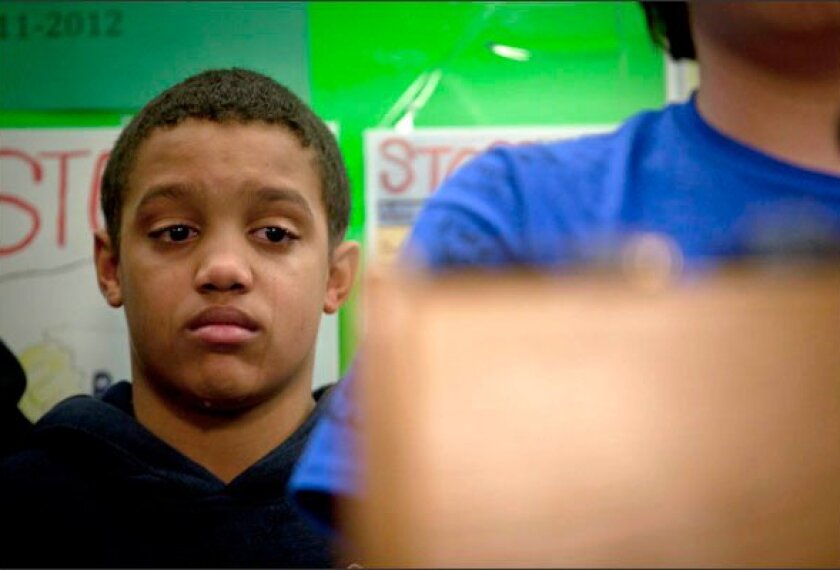Minnesota’s largest school district has agreed to provide significant new protections to prevent the harassment of students who are or are perceived to be lesbian, gay, bisexual, or transgender. The plan settles a lawsuit brought by victims of bullying and brings an end to investigations of the district by the U.S. departments of Education and Justice.
The 40,000-student Anoka-Hennepin school system drew national attention after a string of suicides from 2009 to 2011 by students, some of whom were gay or bisexual, in the district. Families of some of the students said their deaths had been spurred by bullying they had endured in school. The district also had a controversial policy requiring teachers to remain neutral if issues of sexual identity came up in class, which the Anoka-Hennepin school board voted to end earlier this year in response to complaints.
The Atlanta-based Southern Poverty Law Center and the San Francisco-based National Center for Lesbian Rights sued the district in federal court last summer on behalf of six former and current students who said they had been bullied at school because of their real or perceived sexual orientation.
In the suit, the plaintiffs said they were subjected to anti-gay slurs at school, including “dyke,” “homo,” “fag,” and “queer,” nearly every school day. Some said they were told they were sinners or told to kill themselves for being gay. Some reported being urinated upon, stabbed in the neck with a pencil, and pushed into walls and lockers, often while being called anti-gay and gender-related slurs.
“No one should have to go through the kind of harassment that I did,” one of the plaintiffs, freshman Dylon Frei, said in a statement. “I am happy this agreement includes real changes that will make our schools safer and more welcoming for other kids.”
Superintendent Dennis Carlson said the district did act on complaints about harassment and disciplined students found to have bullied classmates. “However, no one would deny that bullying and harassment are real problems in our society and must be more thoroughly and consistently addressed,” he said in a statement.
To resolve the suit, the students, the federal government, and the district will enter a consent decree, which was approved by a federal judge on March 7. The agreement says that teachers can affirm the dignity and self-worth of students, and any protected characteristics of students, such as their sexual orientation, without violating district policy.
It also provides for the six plaintiffs to get a total of $270,000. The Justice and Education departments are to monitor the district’s compliance with the decree through 2017.
This is at least the third such settlement over bullying and harassment the two federal agencies have reached with districts in the past year.
In July, the 4,900-student Tehachapi district in California agreed to revise its policies and regulations related to sexual and gender-based harassment and hire a consultant to provide mandatory training on that topic for all students, administrators, teachers, counselors, and other staff members who interact with students.
That agreement followed an investigation into whether the district had failed to stop or prevent the repeated harassment of 13-year-old student Seth Walsh by his peers. Eventually, Seth hanged himself and died.
A settlement in April with the 5,000-student school district in Owatonna, Minn., resolved complaints by Somali students that they had been harassed at school.
Under the Anoka-Hennepin agreement, the district must, among other steps:
• Hire the Great Lakes Equity Center, at Indiana University-Purdue University Indianapolis, to review and recommend revisions to district policies and practices related to sexual and sexual-orientation-related harassment;
• Fully investigate reports of harassment, escalate remedial efforts when students are repeatedly harassed, and mitigate the effects of harassment;
• Take action to address hostile environments in schools for students who are or are perceived to be lesbian, gay, bisexual, or transgender;
• Develop procedures for notifying parents while maintaining sensitivity to a student’s right of privacy relating to his or her actual or perceived orientation or gender identity;
• Hire a harassment-prevention official to help lead the district’s efforts to eliminate and prevent future harassment in its education programs; and,
• Ensure that a qualified mental-health professional is available during school hours for students in need.
“Unfortunately, this district had become notorious for anti-LGBT hostility and discrimination,” Sam Wolfe, a lawyer for the Southern Poverty Law Center’s LGBT Project, said. “This consent decree sets the stage for Anoka-Hennepin to become a model for other school districts to follow in creating more respectful learning environments for all students in a thoughtful, systemic, and proactive way.”








